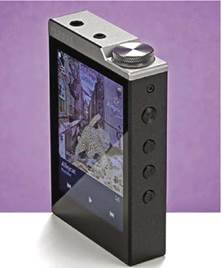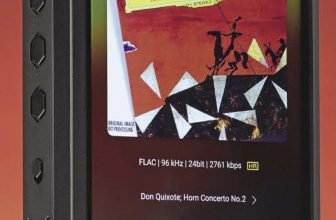iBASSO DX220 Review: Power Player
Noel Keywood goes out and about with a sturdy and advanced portable digital player from iBasso, the DX220.
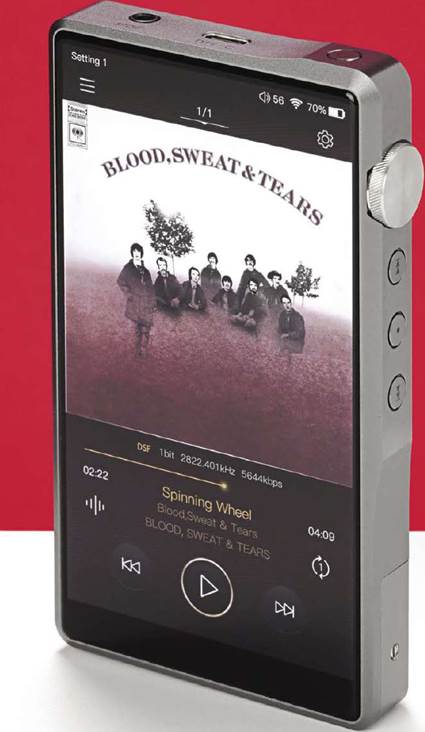
The new DX220 portable digital audio player (DAP) from iBasso is a heavyweight in many senses of the word. Weighing in at a solid 240gms on our scales and built in a solid CNC machined case, it’s pocketable but demands a strong pocket, heavier than an iPhone’s 190gms. It has two top-quality ESS 9028Pro reference digital converters (DACs), one per channel; iBasso says it’s “able to compete with any Hi-End DAC.” And that’s why the price is expensive. This is a large high-end player that borders on being a hi-fi component.
As you might expect, the DX220 is a massively capable player that uses an Android 8.1 operating system to manage many functions beyond simple music replay. There’s wi-fi for music streaming, a Google Chrome web browser, music and games apps (Chinese!), Spotify, a calculator, and a clock. The full-size, high-resolution I080P screen has plenty more space for other apps. But on to the music side of things.
To play music, there’s a Mango player app responsible for putting up the various play screens, menus, and cover artwork. The menu arrangement wasn’t the simplest I had come across, with two track listings styled differently and multiple screen choices with no fewer than three swipe-down screens available while playing a track, one being the alternatively styled tracklist. Tracks could also be skipped by swiping sideways digital filters, but they have little effect on measurement and listening. For more information on all this, see Measured Performance.

iBASSO DX220 Review: SOUND QUALITY
The large volume control on the right has a high resolution. To its left, sit track, skip, and pause/play buttons.
Alternatively, a Settings menu could be coaxed out with a sideways swipe. I found selecting the three swipe-downs was always difficult. Even difficult-to-impossible was returned from Play mode to the initial track listing since the small icon for this at the top right of the screen was unresponsive.
Start-up time was a reasonable 27 seconds. There’s a claimed 8 hours of playing time from the 4400mAh internal rechargeable battery (not removable), but I got around 6 hours with constant play, but the screen is off.
It can be run from an external phone charger (not supplied) with a USB lead (supplied), and as is common, the lead can also be used to load music files to 64GB of internal memory. However, the USB defaults to charge mode and must be manually set for file transfer.
Also, the files don’t appear immediately once loaded and must be manually scanned via a Scanner submenu in Advanced Music play settings – awkward. Most players nowadays do all this automatically.
An SD card slot can address cards up to 2TB – vast capacity. However, DSD files are huge, often 100s of MB, and the DX220 can play up to DSD5I2 (quad DSD), so DSD lovers may have a need – but I have yet to see music above DSDI28. I had no trouble getting DSD onto the player from both a Mac and a PC, although the high data rate of the USB-C terminated cable forced connection directly to my Mac to avoid a USB 2.0 hub. Android interfaces with Windows 10 are better, and the Android loader used by Mac is not needed. The player handles most file types, processing up to 32/384kHz PCM, including WAV and FLAC, of course, plus Apple file types – and DSD with both file headers. It will also handle MQA files from Tidal Masters.
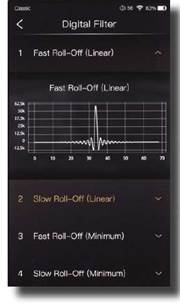
The digital filter interface even gives a time domain graphic.
Importantly for use as a multi-purpose hi-fi player, there is a S/PDIF digital output in electrical and optical form, an analog Line output – surprisingly with variable volume – and two headphone outputs: 3.5mm stereo 3pole jack and 2.5mm stereo 4pole jack (balanced) – both at the bottom of the player. The top face carries a USB C socket and the digital S/PDIF output. The player can be used as a headphone amplifier for a computer or as an external USB-connected DAC to send computer audio to the hi-fi from the Line output.
Two Bluetooth wireless links send music to the hi-fi or receive music from a transmitting source, such as Cambridge Audio’s Alva turntable (see July 2019 issue).
There are three maximum output levels and no less than seven.
The iBasso had ESS sound in spades. There was power and orchestral majesty with the Minnesota Orchestra playing Rimsky-Korsakov’s Dance of the Tumblers from Snow Maiden (24/96). Horns were rich and fruity center stage, the string sections stretching out broadly behind them, with a strong presence at left and right. The DX220 had the feeling of easy but expansive strength here – it lazed along with slick ability, creamy smooth, lusciously revealing, and muscular.

An analog Line output to feed the hi-fi sits on the left. The phone has a standard 3.5mm stereo jack, and BAL has a 2.5mm balanced output for balanced phones.
Similar presentation with Diana Krall’s Narrow Daylight (24/96) where she sang in an atmospheric space, piano having body and strength. ESS DACs can tease out subtle inner details; I could hear this in her fine vocal inflections. They are also creamy smooth, and this quality was conveyed whatever filter was selected, the filters making little difference, although I alighted on two as slightly the best composed.
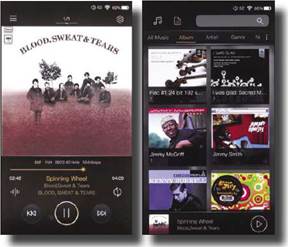
The DX220’s large high-resolution screen displays cover artwork in rich detail, with graphics being delivered by the Mango software player.

The microSD card slot can address up to 2TB, so plenty of storage capacity is needed for DSD.
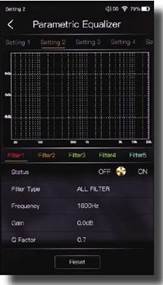
One of the player’s advanced audio facilities is a parametric equalizer.
Playing my scuzzy Rock demo, The Eagles Somebody (CD) from Journey Out of Eden, a heavily compressed track to sound loud, the DX220 handled it well, getting the pace and power and minimizing the harshness. The swirling Hammond organ had menace, and the bass line rolled along unperturbed behind pure Rock thunder.
With DSD the DX220 again showed its stage strength with Santana’s Black Magic Woman (DSD64) where rim shots and cow bell at stage-right and hand drums at stage-left had a nice sense of independent power as Santana cruised smoothly centre stage, classic feedback guitar cutting out of the mix. A player like this shows the quality (or lack of) of old recordings, no matter how well they are transcribed into modern digital format. The crisp sound of Blood Sweat and Tears Spinning Wheel (DSD64) – again with more cowbell! – showed how well this player could differentiate between recordings.
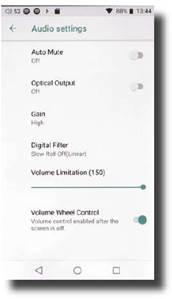
One of the Audio settings sub-screens.

The top face carries a digital S/PDIF output for connection to an external hi-fi DAC or digital amplifier, plus a USB C socket for computer connection.
iBASSO DX220 Review: CONCLUSION
The DX220 is an ambitious player that can stream music from the net, send and receive via Bluetooth, handle all file types, and much more. A top-quality ESS DAC on each channel delivers a powerful and expansive sound. All this comes at a price, however. Its user interface is at iPhone level, and even when in the Mango player, the swipe options are challenging – and moving from internal memory to card is difficult. It also runs warm after a few hours of play since there’s so much inside consuming power. A fine player in sound quality terms and one for those wanting to play/stream music at the highest quality, but it demands involvement.
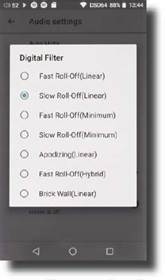
Seven filters – but they little affected sound from CD or hi-res.
iBASSO DX220 Review: MEASURED PERFORMANCE
Frequency response (192kHz sample rate) was measured flat from 5Hz to 91kHz with the Fast filters and slightly less with the Slow filters; there was little difference between them. With CD (44.1 kHz sample rate), there was also little change in the amplitude response, regardless of the filter selected.
Output (High Gain) measured 3V from the 3.5mm unbalanced headphone jack and 6V from the 2.5mm balanced headphone jack – enough to go very loud with all headphones. The Line output delivered 2.9V maximum; this is not a fixed level output, the volume control alters level.
Distortion at peak level (0dB F.S.) measured 0.001% and at -60dB a low 0.01%, with EIAJ Dynamic Range a very high 123dB via the unbalanced balanced and Line outputs.
The DX220 measured very well in all areas.
Frequency response (-1dB)
5Hz-91kHz
Distortion (-60dB) 0.01%
Dynamic range 123dB
Output (unbalanced/bal) 3V / 6V
FREQUENCY RESPONSE

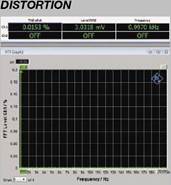
iBASSO DX220
OUTSTANDING – amongst the best.
iBASSO DX220 Review: VERDICT
Advanced MP3 players
+44 (0)343 289 6880
www.advancedmp3players.co.uk

